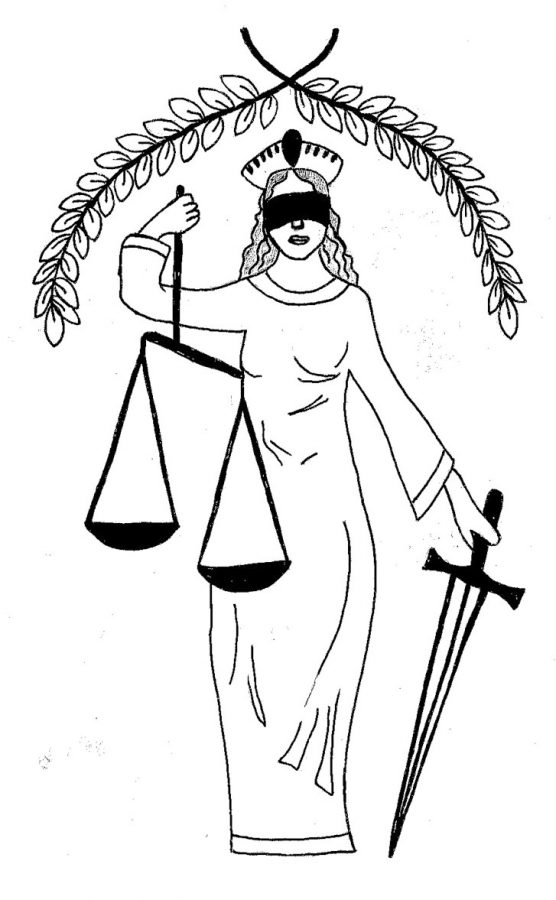Fair Game or Foul Play?
How our justice system is cheating the American people
November 13, 2018
Here in America, we love to talk about how our country is the best of the best. We’re the home of the free, the sanctuary of the liberated, and the ultimate keepers of justice. But even though we talk a big game, these words aren’t reflected in our actions. We pride ourselves on our strong sense of fairness and our pursuit of equality. The problem is, our justice system, which is supposed to uphold those values, is a complete and utter mess.
Let’s talk about plea bargaining: In the court system, a person’s sentence is influenced by whether or not they claim culpability. That means prosecutors are able to dish out lengthier sentences to defendants who plead “not guilty”, and vice versa. While this might seem totally legitimate for those defendants who actually did commit a crime, it completely screws over the innocent. Defendants who didn’t commit any crimes often plead guilty and accept a shorter sentence rather than maintaining their innocence and risking more prison time. It’s not hard to see how harmful this can be, especially because once a defendant pleads guilty their chances of getting exonerated are exceptionally low. Innocence projects are typically only concerned with people who maintained their innocence from the start, and ignore cases where the defendant “confessed” to the crime. It’s a backwards way of looking at things, especially when considering the reasons an innocent defendant might plead guiltyー because they have lost all faith in the system’s ability to serve them real justice.
But there’s more. Fingerprinting, blood spatter, handwriting analysis, DNA, ballistics ー Forensic methods like these are represented in the media as the most quintessential pieces of a criminal investigation. Jury members are conditioned to see them as absolutely reliable, when in reality, these “facts” are often far from that. According to a study from the National Academy of Sciences, a lot of what passes for forensic science doesn’t even come close to meeting minimal scientific standards. This is called unreliable forensic discipline, or the lack of scientific verification behind forensic findings.
Take ballistics for example. When a bullet is fired from a gun, it picks up a set of grooves unique to the firearm it traveled through. Ballistics experts analyze these grooves, then determine if the pattern matches another bullet fired from a specific gun to see if that weapon can be linked to the crime. But how exactly do they determine that? Turns out, there is no scientific baseline that says what constitutes a match and what doesn’t ー no units of measurement, no “at least this similar” rule. The examiner just takes a real good, up close look at the grooves on both bullets and decides for themself whether or not it appears close enough to call. And to be clear, these grooves aren’t exactly easy to map out. They’re tiny, microscopic mazes of individual scratches, each one with varying depth, length, direction, and proportion to one another. With no scientific way of verifying a “match” between two of these complex patterns, conclusions can vary easily from examiner to examiner. That spells out a less than desirable situation for a suspect whose freedom depends on the case.
Subjectivity is a truly a fundamental part of the criminal justice system, and not just because of shoddy forensic science practices. According to The National Initiative for Building Community Trust and Justice, implicit bias “describes the automatic association people make between groups of people and stereotypes about those groups.” Implicit bias is seen all the time in our day-to-day lives. It’s the woman clutching her purse tight when a black man walks by. It’s the assumption that a homeless person must have stolen that tent or bike or dog. But even more than that, it’s the millions of Americans who are targeted by the criminal justice system based on their race, class, gender, or age. One study conducted in Long Island outlined a distinct racial disparity in the number of arrests made on a 73 percent white population. According to the study, for every arrest per 1,000 whites, there was an average of 4.73 arrests per nonwhites. The study shows that the same biases that trigger those tiny everyday responses are also present in police officers, lawyers, juries, and even judges. This translates into our country’s incarceration rates, which are shockingly uneven across certain groups. The imprisonment rate for African Americans is more than 5 times that of whites, with 1 in 10 black men in their thirties in a prison cell on any given day. American Indian youth are three times more likely than white youth to be held in a juvenile detention facility. The fact that people are treated differently as criminal suspects based on race or class doesn’t just signal an ineffective justice system, it also perpetuates institutionalized racism and classism in our country.
The whole point of a criminal justice system is to keep communities safe, support victims, and to make sure offenders are returned to law-abiding citizens after release from jail. However, right now the system isn’t doing its job. The U.S has the highest incarceration rate in the world, costing us billions of dollars each year. Bias clouds the eyes of the people we’re supposed to trust most, while the science used to investigate criminal offenses is often subjective and unreliable. All this paints a not-so-pretty picture: a justice system that fails to accomplish what it should, and fails to do right by the American people.











